MITS5002 - Cloud Computing: Encryption Algorithms & Data Security
VerifiedAdded on 2022/12/15
|7
|2108
|460
Report
AI Summary
This report discusses security issues, mechanisms, and challenges in cloud computing, focusing on data security using encryption algorithms. It examines algorithms like RSA, DES, Blowfish, and AES for ensuring data security in the cloud. The report highlights the importance of data security in cloud computing due to the sensitivity of stored data and the potential risks associated with data management and insider threats. It also addresses security concerns related to physical security, data integrity, and privacy violations. The comparative study of the encryption algorithms aims to provide insights into their effectiveness in securing data during web application access on the cloud, concluding that these algorithms are helpful for current security requirements and suggesting future comparisons for enhanced framework effectiveness. Desklib provides access to similar solved assignments for students.
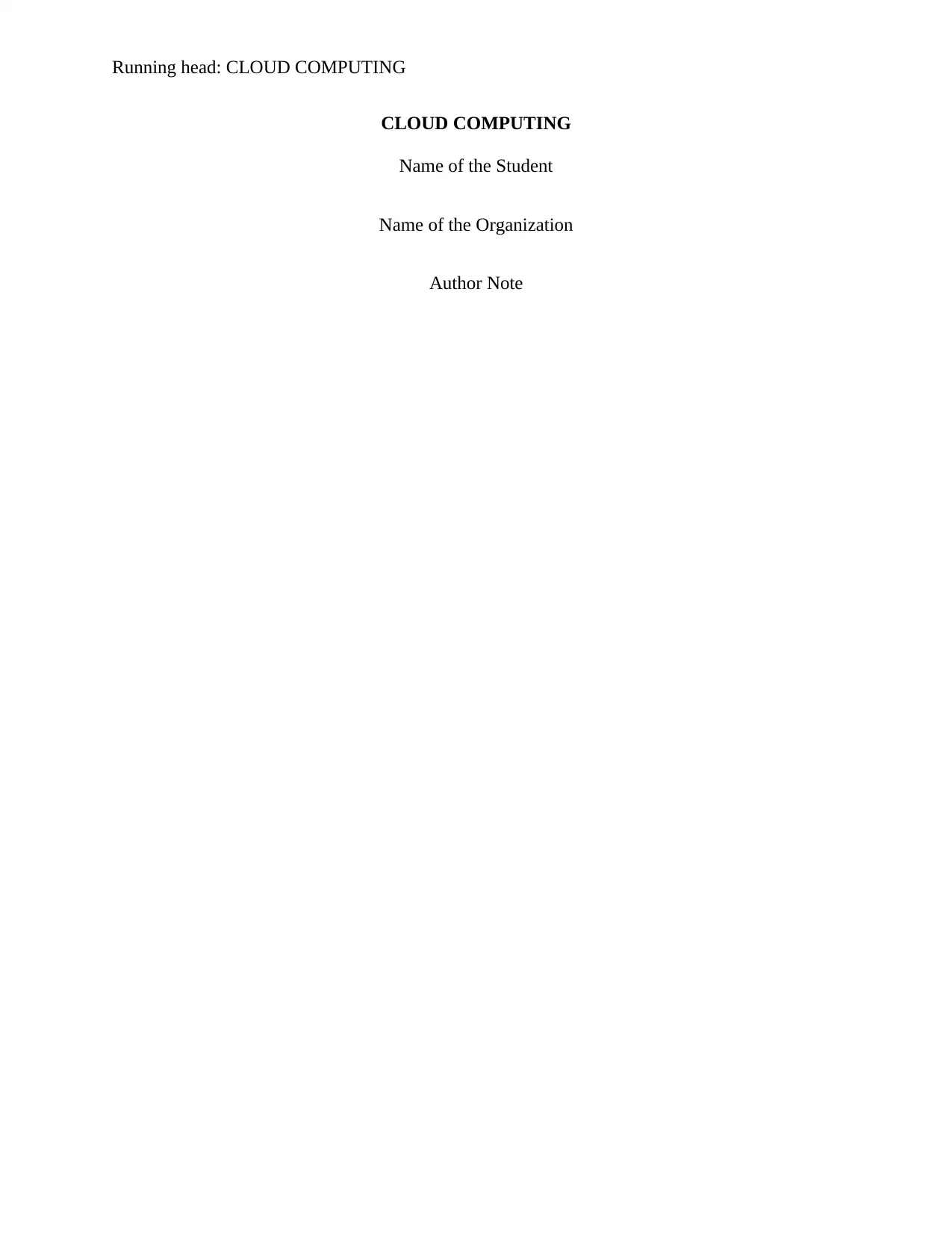
Running head: CLOUD COMPUTING
CLOUD COMPUTING
Name of the Student
Name of the Organization
Author Note
CLOUD COMPUTING
Name of the Student
Name of the Organization
Author Note
Paraphrase This Document
Need a fresh take? Get an instant paraphrase of this document with our AI Paraphraser
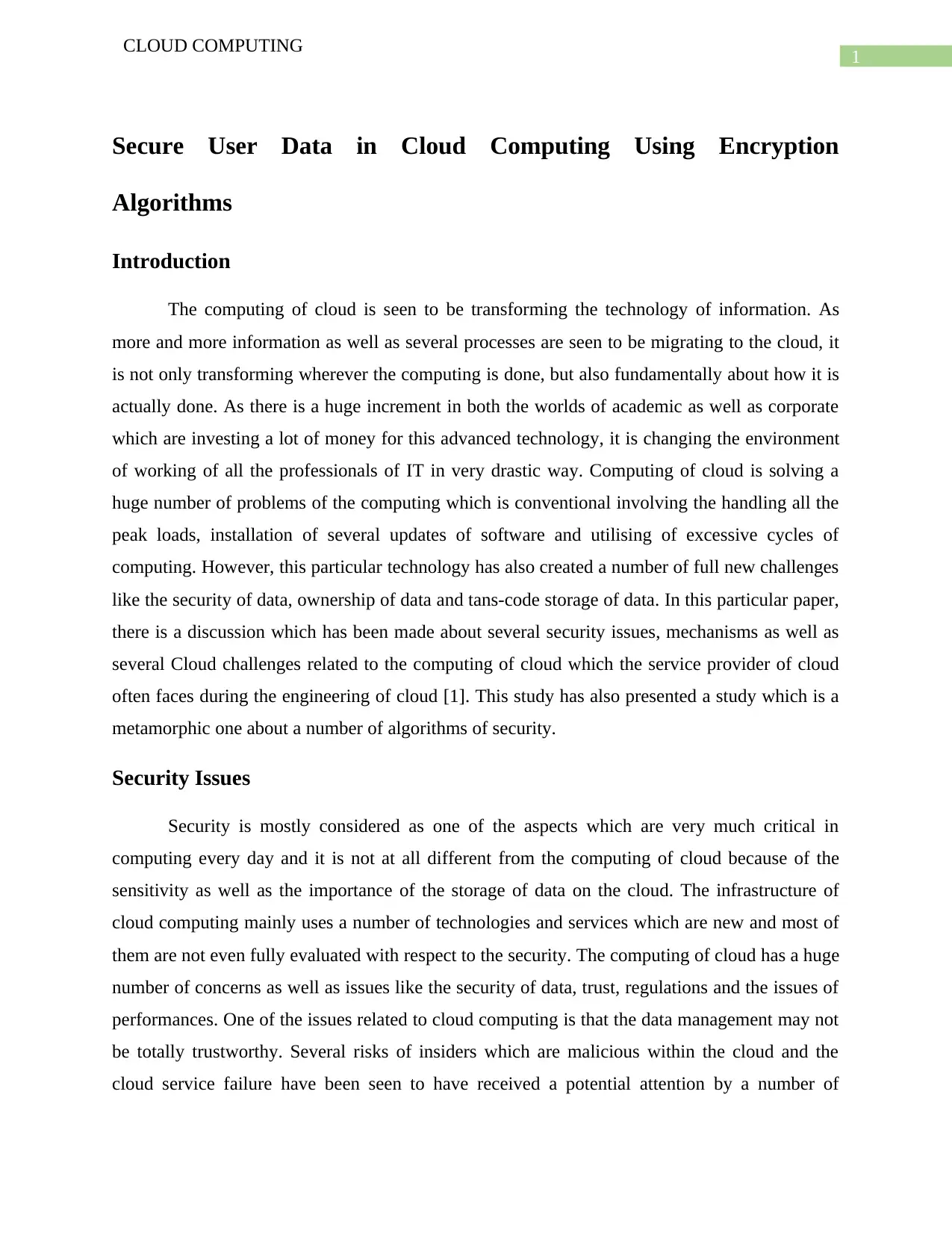
1
CLOUD COMPUTING
Secure User Data in Cloud Computing Using Encryption
Algorithms
Introduction
The computing of cloud is seen to be transforming the technology of information. As
more and more information as well as several processes are seen to be migrating to the cloud, it
is not only transforming wherever the computing is done, but also fundamentally about how it is
actually done. As there is a huge increment in both the worlds of academic as well as corporate
which are investing a lot of money for this advanced technology, it is changing the environment
of working of all the professionals of IT in very drastic way. Computing of cloud is solving a
huge number of problems of the computing which is conventional involving the handling all the
peak loads, installation of several updates of software and utilising of excessive cycles of
computing. However, this particular technology has also created a number of full new challenges
like the security of data, ownership of data and tans-code storage of data. In this particular paper,
there is a discussion which has been made about several security issues, mechanisms as well as
several Cloud challenges related to the computing of cloud which the service provider of cloud
often faces during the engineering of cloud [1]. This study has also presented a study which is a
metamorphic one about a number of algorithms of security.
Security Issues
Security is mostly considered as one of the aspects which are very much critical in
computing every day and it is not at all different from the computing of cloud because of the
sensitivity as well as the importance of the storage of data on the cloud. The infrastructure of
cloud computing mainly uses a number of technologies and services which are new and most of
them are not even fully evaluated with respect to the security. The computing of cloud has a huge
number of concerns as well as issues like the security of data, trust, regulations and the issues of
performances. One of the issues related to cloud computing is that the data management may not
be totally trustworthy. Several risks of insiders which are malicious within the cloud and the
cloud service failure have been seen to have received a potential attention by a number of
CLOUD COMPUTING
Secure User Data in Cloud Computing Using Encryption
Algorithms
Introduction
The computing of cloud is seen to be transforming the technology of information. As
more and more information as well as several processes are seen to be migrating to the cloud, it
is not only transforming wherever the computing is done, but also fundamentally about how it is
actually done. As there is a huge increment in both the worlds of academic as well as corporate
which are investing a lot of money for this advanced technology, it is changing the environment
of working of all the professionals of IT in very drastic way. Computing of cloud is solving a
huge number of problems of the computing which is conventional involving the handling all the
peak loads, installation of several updates of software and utilising of excessive cycles of
computing. However, this particular technology has also created a number of full new challenges
like the security of data, ownership of data and tans-code storage of data. In this particular paper,
there is a discussion which has been made about several security issues, mechanisms as well as
several Cloud challenges related to the computing of cloud which the service provider of cloud
often faces during the engineering of cloud [1]. This study has also presented a study which is a
metamorphic one about a number of algorithms of security.
Security Issues
Security is mostly considered as one of the aspects which are very much critical in
computing every day and it is not at all different from the computing of cloud because of the
sensitivity as well as the importance of the storage of data on the cloud. The infrastructure of
cloud computing mainly uses a number of technologies and services which are new and most of
them are not even fully evaluated with respect to the security. The computing of cloud has a huge
number of concerns as well as issues like the security of data, trust, regulations and the issues of
performances. One of the issues related to cloud computing is that the data management may not
be totally trustworthy. Several risks of insiders which are malicious within the cloud and the
cloud service failure have been seen to have received a potential attention by a number of
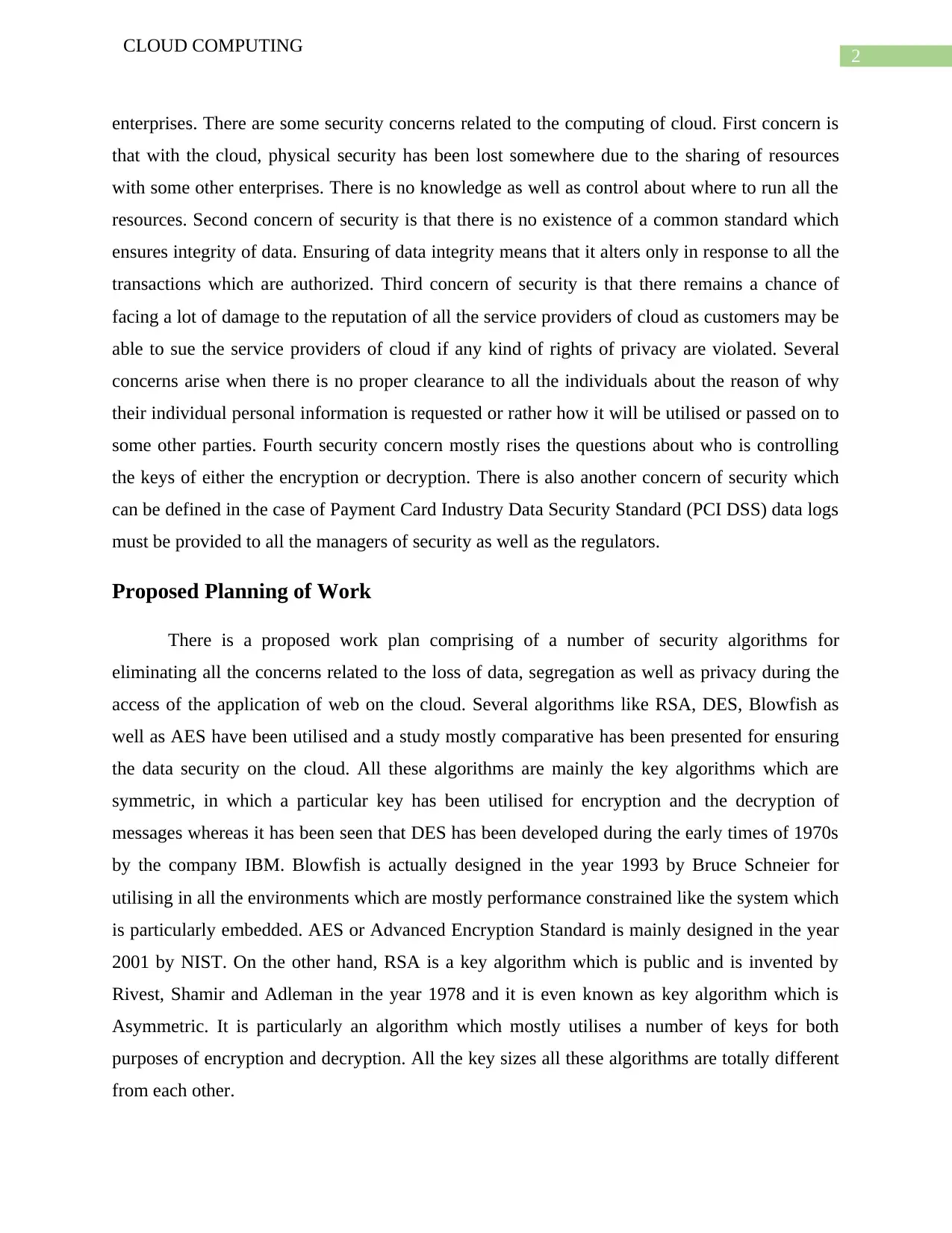
2
CLOUD COMPUTING
enterprises. There are some security concerns related to the computing of cloud. First concern is
that with the cloud, physical security has been lost somewhere due to the sharing of resources
with some other enterprises. There is no knowledge as well as control about where to run all the
resources. Second concern of security is that there is no existence of a common standard which
ensures integrity of data. Ensuring of data integrity means that it alters only in response to all the
transactions which are authorized. Third concern of security is that there remains a chance of
facing a lot of damage to the reputation of all the service providers of cloud as customers may be
able to sue the service providers of cloud if any kind of rights of privacy are violated. Several
concerns arise when there is no proper clearance to all the individuals about the reason of why
their individual personal information is requested or rather how it will be utilised or passed on to
some other parties. Fourth security concern mostly rises the questions about who is controlling
the keys of either the encryption or decryption. There is also another concern of security which
can be defined in the case of Payment Card Industry Data Security Standard (PCI DSS) data logs
must be provided to all the managers of security as well as the regulators.
Proposed Planning of Work
There is a proposed work plan comprising of a number of security algorithms for
eliminating all the concerns related to the loss of data, segregation as well as privacy during the
access of the application of web on the cloud. Several algorithms like RSA, DES, Blowfish as
well as AES have been utilised and a study mostly comparative has been presented for ensuring
the data security on the cloud. All these algorithms are mainly the key algorithms which are
symmetric, in which a particular key has been utilised for encryption and the decryption of
messages whereas it has been seen that DES has been developed during the early times of 1970s
by the company IBM. Blowfish is actually designed in the year 1993 by Bruce Schneier for
utilising in all the environments which are mostly performance constrained like the system which
is particularly embedded. AES or Advanced Encryption Standard is mainly designed in the year
2001 by NIST. On the other hand, RSA is a key algorithm which is public and is invented by
Rivest, Shamir and Adleman in the year 1978 and it is even known as key algorithm which is
Asymmetric. It is particularly an algorithm which mostly utilises a number of keys for both
purposes of encryption and decryption. All the key sizes all these algorithms are totally different
from each other.
CLOUD COMPUTING
enterprises. There are some security concerns related to the computing of cloud. First concern is
that with the cloud, physical security has been lost somewhere due to the sharing of resources
with some other enterprises. There is no knowledge as well as control about where to run all the
resources. Second concern of security is that there is no existence of a common standard which
ensures integrity of data. Ensuring of data integrity means that it alters only in response to all the
transactions which are authorized. Third concern of security is that there remains a chance of
facing a lot of damage to the reputation of all the service providers of cloud as customers may be
able to sue the service providers of cloud if any kind of rights of privacy are violated. Several
concerns arise when there is no proper clearance to all the individuals about the reason of why
their individual personal information is requested or rather how it will be utilised or passed on to
some other parties. Fourth security concern mostly rises the questions about who is controlling
the keys of either the encryption or decryption. There is also another concern of security which
can be defined in the case of Payment Card Industry Data Security Standard (PCI DSS) data logs
must be provided to all the managers of security as well as the regulators.
Proposed Planning of Work
There is a proposed work plan comprising of a number of security algorithms for
eliminating all the concerns related to the loss of data, segregation as well as privacy during the
access of the application of web on the cloud. Several algorithms like RSA, DES, Blowfish as
well as AES have been utilised and a study mostly comparative has been presented for ensuring
the data security on the cloud. All these algorithms are mainly the key algorithms which are
symmetric, in which a particular key has been utilised for encryption and the decryption of
messages whereas it has been seen that DES has been developed during the early times of 1970s
by the company IBM. Blowfish is actually designed in the year 1993 by Bruce Schneier for
utilising in all the environments which are mostly performance constrained like the system which
is particularly embedded. AES or Advanced Encryption Standard is mainly designed in the year
2001 by NIST. On the other hand, RSA is a key algorithm which is public and is invented by
Rivest, Shamir and Adleman in the year 1978 and it is even known as key algorithm which is
Asymmetric. It is particularly an algorithm which mostly utilises a number of keys for both
purposes of encryption and decryption. All the key sizes all these algorithms are totally different
from each other.
⊘ This is a preview!⊘
Do you want full access?
Subscribe today to unlock all pages.

Trusted by 1+ million students worldwide
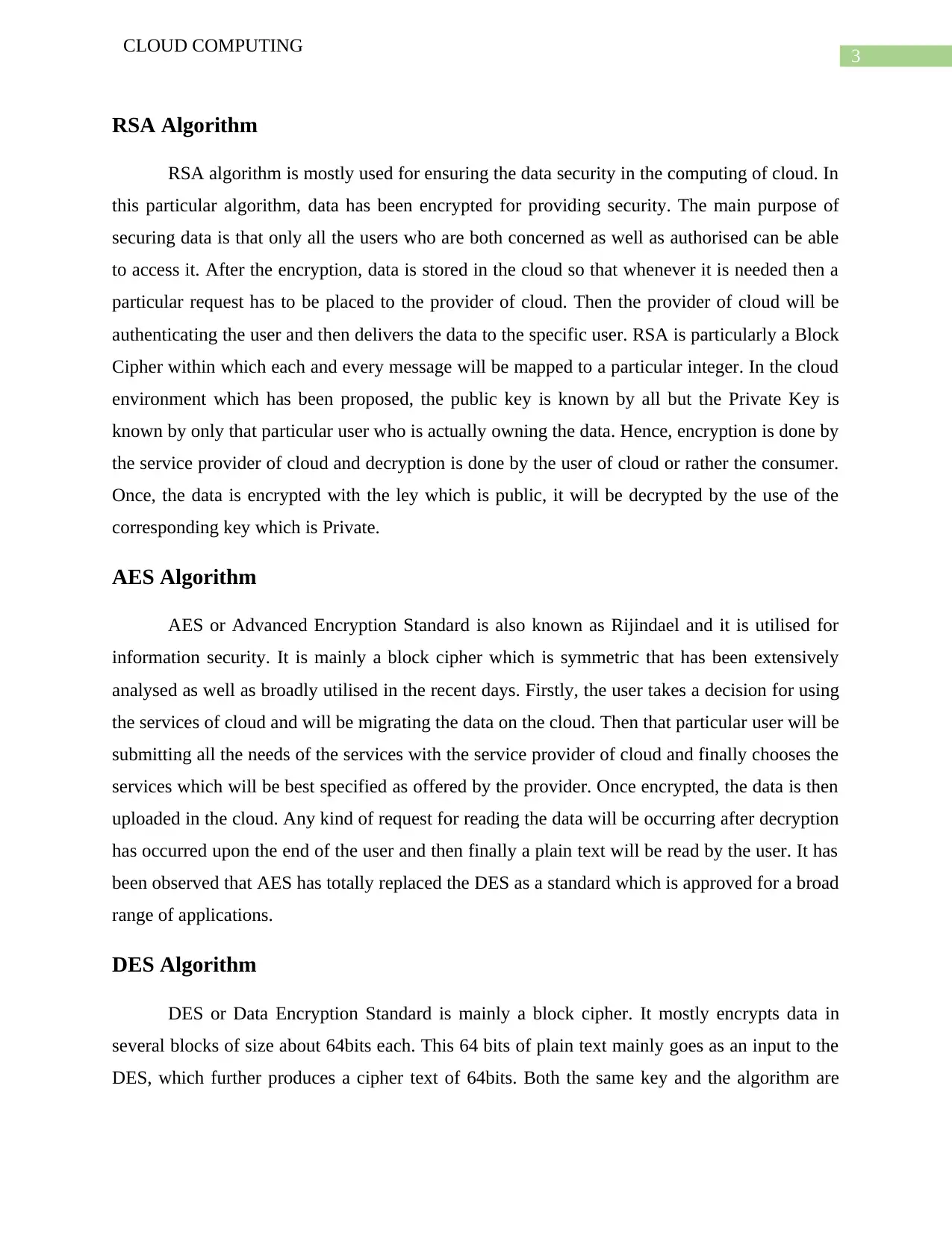
3
CLOUD COMPUTING
RSA Algorithm
RSA algorithm is mostly used for ensuring the data security in the computing of cloud. In
this particular algorithm, data has been encrypted for providing security. The main purpose of
securing data is that only all the users who are both concerned as well as authorised can be able
to access it. After the encryption, data is stored in the cloud so that whenever it is needed then a
particular request has to be placed to the provider of cloud. Then the provider of cloud will be
authenticating the user and then delivers the data to the specific user. RSA is particularly a Block
Cipher within which each and every message will be mapped to a particular integer. In the cloud
environment which has been proposed, the public key is known by all but the Private Key is
known by only that particular user who is actually owning the data. Hence, encryption is done by
the service provider of cloud and decryption is done by the user of cloud or rather the consumer.
Once, the data is encrypted with the ley which is public, it will be decrypted by the use of the
corresponding key which is Private.
AES Algorithm
AES or Advanced Encryption Standard is also known as Rijindael and it is utilised for
information security. It is mainly a block cipher which is symmetric that has been extensively
analysed as well as broadly utilised in the recent days. Firstly, the user takes a decision for using
the services of cloud and will be migrating the data on the cloud. Then that particular user will be
submitting all the needs of the services with the service provider of cloud and finally chooses the
services which will be best specified as offered by the provider. Once encrypted, the data is then
uploaded in the cloud. Any kind of request for reading the data will be occurring after decryption
has occurred upon the end of the user and then finally a plain text will be read by the user. It has
been observed that AES has totally replaced the DES as a standard which is approved for a broad
range of applications.
DES Algorithm
DES or Data Encryption Standard is mainly a block cipher. It mostly encrypts data in
several blocks of size about 64bits each. This 64 bits of plain text mainly goes as an input to the
DES, which further produces a cipher text of 64bits. Both the same key and the algorithm are
CLOUD COMPUTING
RSA Algorithm
RSA algorithm is mostly used for ensuring the data security in the computing of cloud. In
this particular algorithm, data has been encrypted for providing security. The main purpose of
securing data is that only all the users who are both concerned as well as authorised can be able
to access it. After the encryption, data is stored in the cloud so that whenever it is needed then a
particular request has to be placed to the provider of cloud. Then the provider of cloud will be
authenticating the user and then delivers the data to the specific user. RSA is particularly a Block
Cipher within which each and every message will be mapped to a particular integer. In the cloud
environment which has been proposed, the public key is known by all but the Private Key is
known by only that particular user who is actually owning the data. Hence, encryption is done by
the service provider of cloud and decryption is done by the user of cloud or rather the consumer.
Once, the data is encrypted with the ley which is public, it will be decrypted by the use of the
corresponding key which is Private.
AES Algorithm
AES or Advanced Encryption Standard is also known as Rijindael and it is utilised for
information security. It is mainly a block cipher which is symmetric that has been extensively
analysed as well as broadly utilised in the recent days. Firstly, the user takes a decision for using
the services of cloud and will be migrating the data on the cloud. Then that particular user will be
submitting all the needs of the services with the service provider of cloud and finally chooses the
services which will be best specified as offered by the provider. Once encrypted, the data is then
uploaded in the cloud. Any kind of request for reading the data will be occurring after decryption
has occurred upon the end of the user and then finally a plain text will be read by the user. It has
been observed that AES has totally replaced the DES as a standard which is approved for a broad
range of applications.
DES Algorithm
DES or Data Encryption Standard is mainly a block cipher. It mostly encrypts data in
several blocks of size about 64bits each. This 64 bits of plain text mainly goes as an input to the
DES, which further produces a cipher text of 64bits. Both the same key and the algorithm are
Paraphrase This Document
Need a fresh take? Get an instant paraphrase of this document with our AI Paraphraser
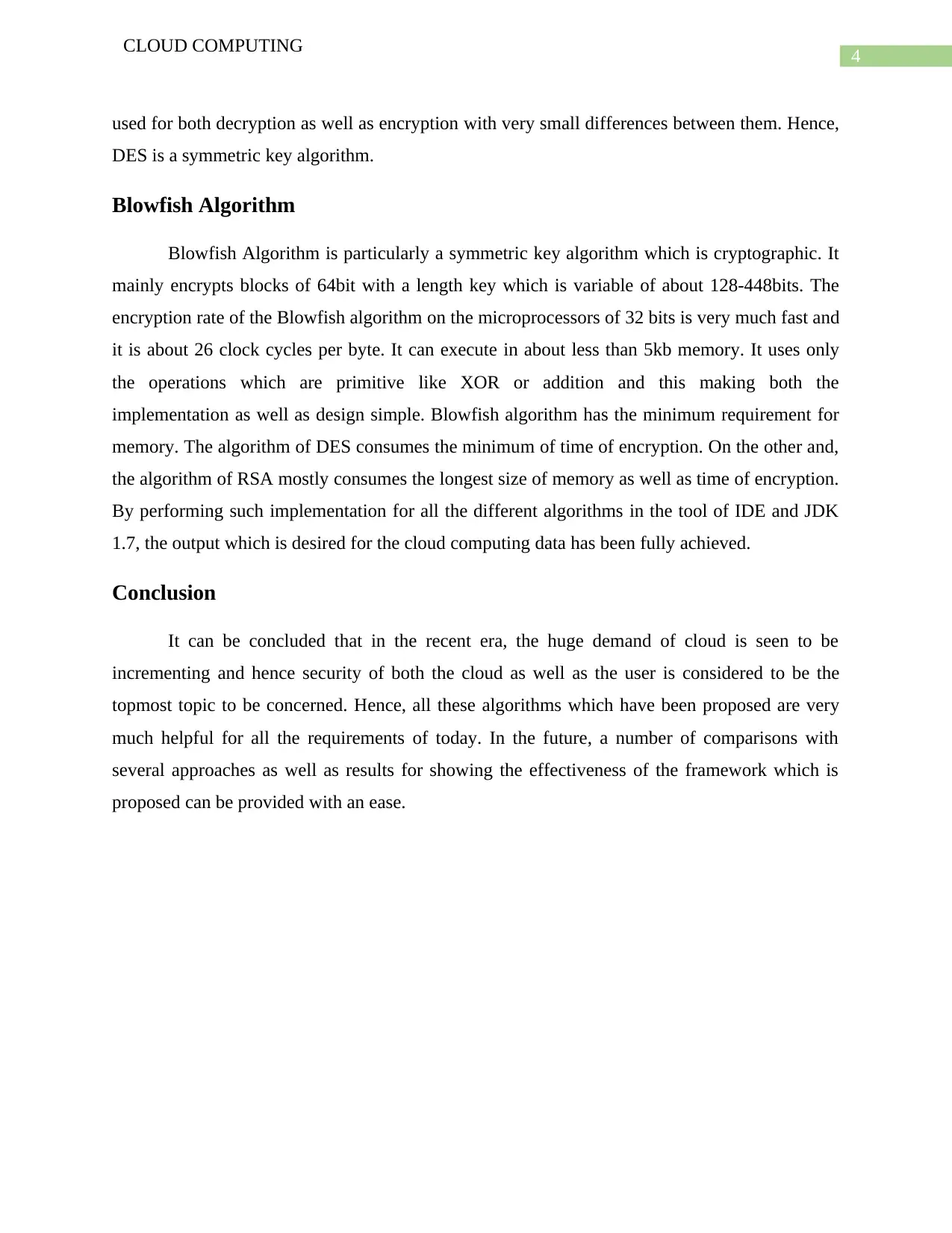
4
CLOUD COMPUTING
used for both decryption as well as encryption with very small differences between them. Hence,
DES is a symmetric key algorithm.
Blowfish Algorithm
Blowfish Algorithm is particularly a symmetric key algorithm which is cryptographic. It
mainly encrypts blocks of 64bit with a length key which is variable of about 128-448bits. The
encryption rate of the Blowfish algorithm on the microprocessors of 32 bits is very much fast and
it is about 26 clock cycles per byte. It can execute in about less than 5kb memory. It uses only
the operations which are primitive like XOR or addition and this making both the
implementation as well as design simple. Blowfish algorithm has the minimum requirement for
memory. The algorithm of DES consumes the minimum of time of encryption. On the other and,
the algorithm of RSA mostly consumes the longest size of memory as well as time of encryption.
By performing such implementation for all the different algorithms in the tool of IDE and JDK
1.7, the output which is desired for the cloud computing data has been fully achieved.
Conclusion
It can be concluded that in the recent era, the huge demand of cloud is seen to be
incrementing and hence security of both the cloud as well as the user is considered to be the
topmost topic to be concerned. Hence, all these algorithms which have been proposed are very
much helpful for all the requirements of today. In the future, a number of comparisons with
several approaches as well as results for showing the effectiveness of the framework which is
proposed can be provided with an ease.
CLOUD COMPUTING
used for both decryption as well as encryption with very small differences between them. Hence,
DES is a symmetric key algorithm.
Blowfish Algorithm
Blowfish Algorithm is particularly a symmetric key algorithm which is cryptographic. It
mainly encrypts blocks of 64bit with a length key which is variable of about 128-448bits. The
encryption rate of the Blowfish algorithm on the microprocessors of 32 bits is very much fast and
it is about 26 clock cycles per byte. It can execute in about less than 5kb memory. It uses only
the operations which are primitive like XOR or addition and this making both the
implementation as well as design simple. Blowfish algorithm has the minimum requirement for
memory. The algorithm of DES consumes the minimum of time of encryption. On the other and,
the algorithm of RSA mostly consumes the longest size of memory as well as time of encryption.
By performing such implementation for all the different algorithms in the tool of IDE and JDK
1.7, the output which is desired for the cloud computing data has been fully achieved.
Conclusion
It can be concluded that in the recent era, the huge demand of cloud is seen to be
incrementing and hence security of both the cloud as well as the user is considered to be the
topmost topic to be concerned. Hence, all these algorithms which have been proposed are very
much helpful for all the requirements of today. In the future, a number of comparisons with
several approaches as well as results for showing the effectiveness of the framework which is
proposed can be provided with an ease.
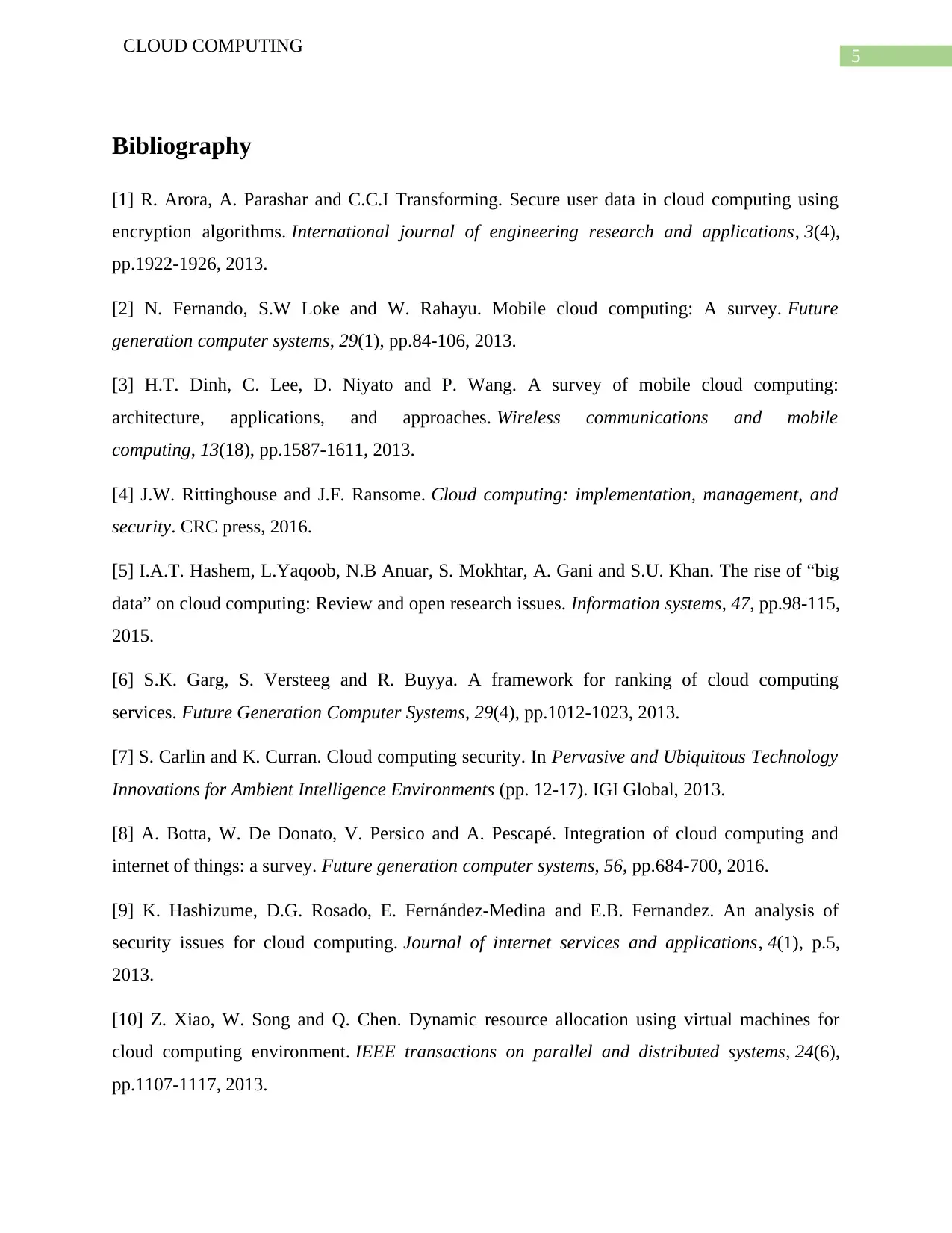
5
CLOUD COMPUTING
Bibliography
[1] R. Arora, A. Parashar and C.C.I Transforming. Secure user data in cloud computing using
encryption algorithms. International journal of engineering research and applications, 3(4),
pp.1922-1926, 2013.
[2] N. Fernando, S.W Loke and W. Rahayu. Mobile cloud computing: A survey. Future
generation computer systems, 29(1), pp.84-106, 2013.
[3] H.T. Dinh, C. Lee, D. Niyato and P. Wang. A survey of mobile cloud computing:
architecture, applications, and approaches. Wireless communications and mobile
computing, 13(18), pp.1587-1611, 2013.
[4] J.W. Rittinghouse and J.F. Ransome. Cloud computing: implementation, management, and
security. CRC press, 2016.
[5] I.A.T. Hashem, L.Yaqoob, N.B Anuar, S. Mokhtar, A. Gani and S.U. Khan. The rise of “big
data” on cloud computing: Review and open research issues. Information systems, 47, pp.98-115,
2015.
[6] S.K. Garg, S. Versteeg and R. Buyya. A framework for ranking of cloud computing
services. Future Generation Computer Systems, 29(4), pp.1012-1023, 2013.
[7] S. Carlin and K. Curran. Cloud computing security. In Pervasive and Ubiquitous Technology
Innovations for Ambient Intelligence Environments (pp. 12-17). IGI Global, 2013.
[8] A. Botta, W. De Donato, V. Persico and A. Pescapé. Integration of cloud computing and
internet of things: a survey. Future generation computer systems, 56, pp.684-700, 2016.
[9] K. Hashizume, D.G. Rosado, E. Fernández-Medina and E.B. Fernandez. An analysis of
security issues for cloud computing. Journal of internet services and applications, 4(1), p.5,
2013.
[10] Z. Xiao, W. Song and Q. Chen. Dynamic resource allocation using virtual machines for
cloud computing environment. IEEE transactions on parallel and distributed systems, 24(6),
pp.1107-1117, 2013.
CLOUD COMPUTING
Bibliography
[1] R. Arora, A. Parashar and C.C.I Transforming. Secure user data in cloud computing using
encryption algorithms. International journal of engineering research and applications, 3(4),
pp.1922-1926, 2013.
[2] N. Fernando, S.W Loke and W. Rahayu. Mobile cloud computing: A survey. Future
generation computer systems, 29(1), pp.84-106, 2013.
[3] H.T. Dinh, C. Lee, D. Niyato and P. Wang. A survey of mobile cloud computing:
architecture, applications, and approaches. Wireless communications and mobile
computing, 13(18), pp.1587-1611, 2013.
[4] J.W. Rittinghouse and J.F. Ransome. Cloud computing: implementation, management, and
security. CRC press, 2016.
[5] I.A.T. Hashem, L.Yaqoob, N.B Anuar, S. Mokhtar, A. Gani and S.U. Khan. The rise of “big
data” on cloud computing: Review and open research issues. Information systems, 47, pp.98-115,
2015.
[6] S.K. Garg, S. Versteeg and R. Buyya. A framework for ranking of cloud computing
services. Future Generation Computer Systems, 29(4), pp.1012-1023, 2013.
[7] S. Carlin and K. Curran. Cloud computing security. In Pervasive and Ubiquitous Technology
Innovations for Ambient Intelligence Environments (pp. 12-17). IGI Global, 2013.
[8] A. Botta, W. De Donato, V. Persico and A. Pescapé. Integration of cloud computing and
internet of things: a survey. Future generation computer systems, 56, pp.684-700, 2016.
[9] K. Hashizume, D.G. Rosado, E. Fernández-Medina and E.B. Fernandez. An analysis of
security issues for cloud computing. Journal of internet services and applications, 4(1), p.5,
2013.
[10] Z. Xiao, W. Song and Q. Chen. Dynamic resource allocation using virtual machines for
cloud computing environment. IEEE transactions on parallel and distributed systems, 24(6),
pp.1107-1117, 2013.
⊘ This is a preview!⊘
Do you want full access?
Subscribe today to unlock all pages.

Trusted by 1+ million students worldwide
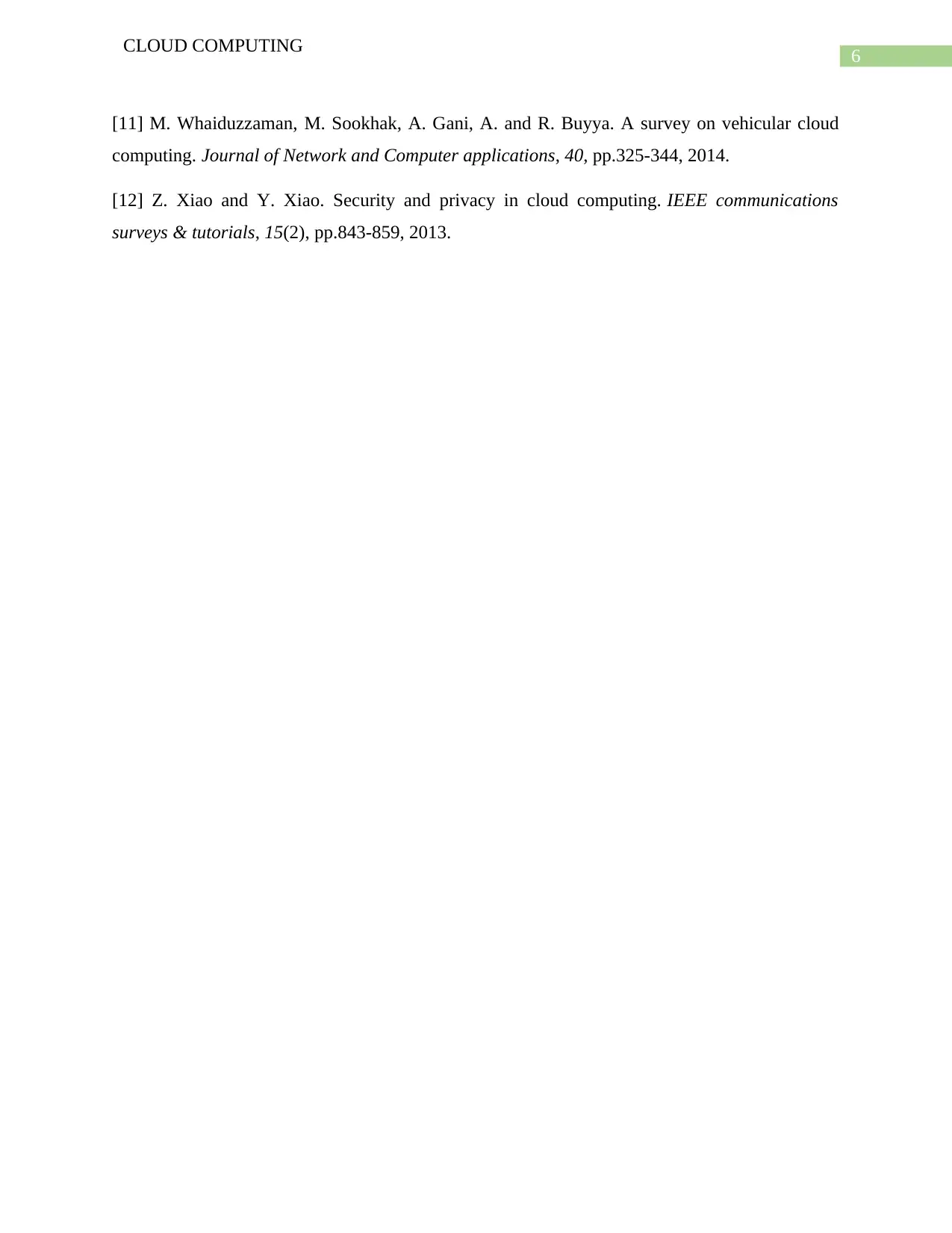
6
CLOUD COMPUTING
[11] M. Whaiduzzaman, M. Sookhak, A. Gani, A. and R. Buyya. A survey on vehicular cloud
computing. Journal of Network and Computer applications, 40, pp.325-344, 2014.
[12] Z. Xiao and Y. Xiao. Security and privacy in cloud computing. IEEE communications
surveys & tutorials, 15(2), pp.843-859, 2013.
CLOUD COMPUTING
[11] M. Whaiduzzaman, M. Sookhak, A. Gani, A. and R. Buyya. A survey on vehicular cloud
computing. Journal of Network and Computer applications, 40, pp.325-344, 2014.
[12] Z. Xiao and Y. Xiao. Security and privacy in cloud computing. IEEE communications
surveys & tutorials, 15(2), pp.843-859, 2013.
1 out of 7
Related Documents
Your All-in-One AI-Powered Toolkit for Academic Success.
+13062052269
info@desklib.com
Available 24*7 on WhatsApp / Email
![[object Object]](/_next/static/media/star-bottom.7253800d.svg)
Unlock your academic potential
Copyright © 2020–2025 A2Z Services. All Rights Reserved. Developed and managed by ZUCOL.




